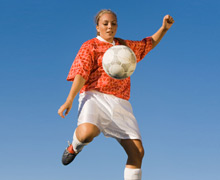
A study from Australia gives new meaning to the term pumping iron for female athletes. That’s because although they may be comfortable in the weight room pumping iron researchers say they need to be more conscious about getting the vital mineral iron in their diet.
Scientists from the University of Western Australia (UWA), Edith Cowan University (ECU), and the WA Institute of Sport (WAIS) collaborated to review existing research and discovered female athletes are more likely to be iron deficient. The results of the study published in the European Journal of Applied Physiology showed up to 35 percent of female athletes have low iron levels compared to only five percent of the general female population in Australia.
By comparison, researchers found 11 percent of male athletes in Australia were iron deficient and just one percent of all males.
The U.S. Centers for Disease Control and Prevention says almost 10% of women in America are iron deficient without breaking out the number for athletes. If the ratio is similar it would make the number of female athletes in the U.S. who have low iron even greater than 35 percent.
Iron is essential for the production of red blood cells and is vital in transporting oxygen throughout the body. About 70 percent of the body’s iron is found in the red blood cells.
Researcher Dr. Marc Sim said he and his team looked at competitive athletes but the results are consistent with those who regularly exercise. "There are a number of ways that doing a lot of exercise can inhibit the body's ability to absorb iron," Dr. Sim said. "Firstly, exercise promotes the production of a hormone that inhibits the gut's ability to absorb iron.”
Some of the symptoms of iron deficiency include fatigue, lethargy and delayed recovery after exertion. It can also affect athletic performance.
"We also know that the repeated impact on the body from running can actually destroy red blood cells, which carry iron and oxygen around the body,” Dr. Sim said. "People who exercise a lot are also more likely to have an energy deficit that can increase the risk of an iron deficiency."
Increasing dietary iron or supplementing are necessary for combatting low iron levels researcher Peter Peeling said.
"The first approach for iron deficient athletes is to increase dietary iron intake by eating foods like red meat, beans, lentils and leafy green vegetables," Professor Peeling said. “The most common next approach is to consume an oral iron supplement. If the athlete remains unresponsive, their doctor may then consider the use of an intravenous infusion."
Professor peeling said it’s important to keep your activity level in mind before testing. "In the same way that you need to fast before a blood glucose test to get an accurate result, you should avoid doing strenuous exercise before having your iron levels checked," he said.
Click here to read more in the European Journal of Applied Physiology.
